| Listing 1 - 10 of 12 | << page >> |
Sort by
|
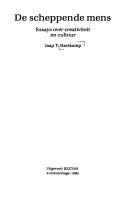
ISBN: 906291151X 9789062911516 Year: 1984 Publisher: 's-Gravenhage BZZTôH
Abstract | Keywords | Export | Availability | Bookmark
 Loading...
Loading...Choose an application
- Reference Manager
- EndNote
- RefWorks (Direct export to RefWorks)
History of civilization --- European literature --- Creative ability --- Creation (Literary, artistic, etc.) --- History --- -European literature --- -Creative ability --- -Creativeness --- Creativity --- Ability --- Creative ability in art --- Creative ability in literature --- Art --- Imagination --- Inspiration --- Literature --- Originality --- History. --- -History --- Creativeness --- European literature - 20th century --- Creative ability - History --- Creation (Literary, artistic, etc.) - History --- European literature - 19th century
Book
ISBN: 0520029798 9780520029798 Year: 1976 Publisher: Berkeley, Calif.
Abstract | Keywords | Export | Availability | Bookmark
 Loading...
Loading...Choose an application
- Reference Manager
- EndNote
- RefWorks (Direct export to RefWorks)
Depth psychology --- Eliot, George --- Creation (Literary, artistic, etc) --- Women and literature --- Didactic fiction, English --- History --- History and criticism --- Eliot, George, --- Criticism and interpretation --- Creation (Literary, artistic, etc) - History - 19th century --- Women and literature - England - History - 19th century --- Didactic fiction, English - History and criticism --- Eliot, George, - 1819-1880 - Criticism and interpretation --- Eliot, George, - 1819-1880
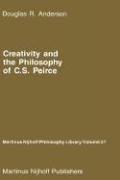
ISBN: 9024735742 9048183057 9401577609 9789024735747 Year: 1987 Volume: 27 Publisher: Dordrecht
Abstract | Keywords | Export | Availability | Bookmark
 Loading...
Loading...Choose an application
- Reference Manager
- EndNote
- RefWorks (Direct export to RefWorks)
Peirce, Charles Sanders --- Creation (Literary, artistic, etc.) --- History --- -Creative ability in art --- Creative ability in literature --- Art --- Imagination --- Inspiration --- Literature --- Creative ability --- Originality --- Peirce, Charles S. --- -History --- Creative ability in art --- Peirce, Charles Sanders, --- Peirce, C. S. --- Pirs, Charlz S., --- Peirce, Charles Santiago Sanders, --- Pʻo-erh-ssu, --- Pʻo-erh-ssu, Chʻa-li-ssu, --- Purs, Charls, --- Пърс, Чарлс, --- Chaersi Sangdesi Piersi, --- 查尔斯·桑德斯·皮尔斯, --- Creation (Literary, artistic, etc.) - History
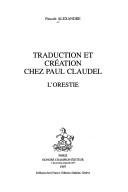
ISSN: 11692952 ISBN: 2852035693 9782852035690 Year: 1997 Volume: 3 Publisher: Paris Honoré Champion
Abstract | Keywords | Export | Availability | Bookmark
 Loading...
Loading...Choose an application
- Reference Manager
- EndNote
- RefWorks (Direct export to RefWorks)
Pourquoi, en cette fin de siècle symboliste, entreprendre la traduction de l'Agamemnon d'Escgyle ? Pourquoi, vingt ans après, revenir au tragique grec pour achever l'Orestie avec les Choéphores et les Euménides ? Pourquoi avoir tant souhaité la représentation de l'antique trilogie, mise en musique en étroite collaboration avec Darius Milhaud ? Comme l'écrit Yves Bonnefoy, "si la traduction n'est pas une copie, et une technique, mais un questionnement, et une expérience, elle ne peut s'inscrire - s'écrire - que dans la durée d'une vie, dont elle sollicitera tous les aspects, tous les actes." Indissociable de la création claudélienne qu'elle illustre et éclaire à la fois, quête spéculaire en même temps que décentrement ouvrant sur une Grèce inédite, l'Orestie prend place au coeur d'une modernité qui conjugue volontiers traduction et littérature.
Tragedy --- Creation (Literary, artistic, etc.) --- Greek language --- Mythology, Greek, in literature --- Orestes (Greek mythology) in literature --- Translating into French --- Aeschylus --- Claudel, Paul --- Translations into French --- History and criticism --- Contributions in translating and interpreting --- History --- Aeschylus. --- Claudel, Paul, --- Knowledge --- Translating and interpreting --- Greek language - Translating into French --- Creation (Literary, artistic, etc.) - History - 20th century. --- Aeschylus - Translations into French - History and criticism --- Aeschylus. - Oresteia --- Claudel, Paul, - 1868-1955 - Knowledge - Translating and interpreting --- Claudel, Paul, - 1868-1955
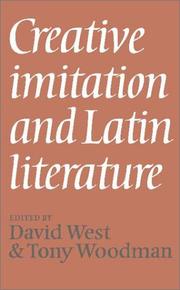
ISBN: 0521226686 0521036399 0511659172 9780521036399 9780511659171 9780521226684 Year: 1979 Publisher: Cambridge
Abstract | Keywords | Export | Availability | Bookmark
 Loading...
Loading...Choose an application
- Reference Manager
- EndNote
- RefWorks (Direct export to RefWorks)
The poets and prose-writers of Greece and Rome were acutely conscious of their literary heritage. They expressed this consciousness in the regularity with which, in their writings, they imitated and alluded to the great authors who had preceded them. Such imitation was generally not regarded as plagiarism but as essential to the creation of a new literary work: imitating one's predecessors was in no way incompatible with originality or progress. These views were not peculiar to the writers of Greece and Rome but were adopted by many others who have written in the 'classical tradition' right up to modern times. Creative Imitation and Latin Literature is an exploration of this concept of imitation. The contributors analyse selected passages from various authors - Greek, Latin and English - in order to demonstrate how Latin authors created new works of art by imitating earlier passages of literature.
Comparative literature --- Classical Latin language --- Latin literature --- Littérature latine --- History and criticism --- Histoire et critique --- Creation (Literary, artistic, etc.) --- Imitation in literature --- -871 --- Roman literature --- Classical literature --- Classical philology --- Latin philology --- Quotation --- Style, Literary --- Mimesis in literature --- Originality in literature --- Plagiarism --- Creative ability in art --- Creative ability in literature --- Art --- Imagination --- Inspiration --- Literature --- Creative ability --- Originality --- Latijnse literatuur --- Rome --- Civilization. --- Imitation in literature. --- History --- History and criticism. --- 871 Latijnse literatuur --- Littérature latine --- 871 --- Literary style --- 871 Latin literature --- Arts and Humanities --- Latin literature - History and criticism --- Creation (Literary, artistic, etc.) - History - To 1500 --- Rome - Civilization
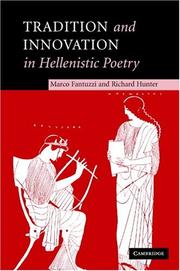
ISBN: 0521835119 9780521835114 9780511482151 9780521203609 051108059X 9780511080593 0511482159 9780511079832 0511079834 1107139546 9781107139541 1280415665 9781280415661 0511170661 9780511170669 0511206623 9780511206627 0511297815 9780511297816 0521203600 Year: 2004 Publisher: Cambridge, England New York Cambridge University Press
Abstract | Keywords | Export | Availability | Bookmark
 Loading...
Loading...Choose an application
- Reference Manager
- EndNote
- RefWorks (Direct export to RefWorks)
Hellenistic poets of the third and second centuries BC were concerned with the need both to mark their continuity with the classical past and to demonstrate their independence from it. In this revised and expanded translation of Muse e modelli: la poesia ellenistica da Alessandro Magno ad Augusto, Greek poetry of the third and second centuries BC and its reception and influence at Rome are explored allowing both sides of this literary practice to be appreciated. Genres as diverse as epic and epigram are considered from a historical perspective, in the full range of their deep-level structures, providing a different perspective on the poetry and its influence at Rome. Some of the most famous poetry of the age such as Callimachus' Aitia and Apollonius' Argonautica is examined. In addition, full attention is paid to the poetry of encomium, in particular the newly published epigrams of Posidippus, and Hellenistic poetics, notably Philodemus.
Greek poetry, Hellenistic --- Influence (Literary, artistic, etc.) --- Creation (Literary, artistic, etc.) --- Poésie grecque hellénistique --- Influence littéraire, artistique, etc. --- Création (Arts) --- History and criticism. --- Histoire et critique --- History and criticism --- History --- Poésie grecque hellénistique --- Influence littéraire, artistique, etc. --- Création (Arts) --- Creative ability in art --- Creative ability in literature --- Art --- Imagination --- Inspiration --- Literature --- Creative ability --- Originality --- Greek poetry [Hellenistic ] --- To 500 --- Arts and Humanities --- Greek poetry, Hellenistic - History and criticism --- Influence (Literary, artistic, etc.) - History - To 500 --- Creation (Literary, artistic, etc.) - History - To 500 --- Antiquité
Book
ISBN: 9462094594 1306279895 9462094616 9462094608 9789462094611 9789462094598 9789462094604 Year: 2013 Publisher: Rotteram ; Boston : Sense Publishers,
Abstract | Keywords | Export | Availability | Bookmark
 Loading...
Loading...Choose an application
- Reference Manager
- EndNote
- RefWorks (Direct export to RefWorks)
The Mediterranean is a multifaceted conglomeration of parts that cannot be assembled into a whole. Its various histories characterised by imperial and nationalistic aspirations, imbalances of power and economies, political struggles, diverse cultural, religious and linguistic realities as well as the countless myths spawned by people over the ages all contribute to the world's fascination with this region and simultaneously make it difficult for anyone to speak sensibly about it without resorting to the plural form – the Mediterraneans. So, can we speak of a Mediterranean pedagogy of the arts? The authors in this volume argue in different ways that the answer to this question cannot be carved out of a singular, monolithic interpretation of the region. Instead, we need to look for provisional answers in the region’s dynamic developments, historic and contemporary exchanges of ideas and cultural codes and in the shifting nature of a sea that invites journeying, inquisitive people to discover new routes. The cover image, “La fenêtre intérieure”, is by the French photographer Sébastien Cailleux and shows a multiple exposure portrait of a child and her drawing created during a workshop called “Dessine-moi la Méditerranée”, organised by L’École d’Art au Village (Edaav) at the Museum of Illumination, Miniatures and Calligraphy at the Casbah in Algiers.
Architecture -- Mediterranean Region. --- Arts -- Mediterranean Region. --- Creation (Literary, artistic, etc.) -- History. --- Art, Architecture & Applied Arts --- Education --- Social Sciences --- Fine Arts - General --- Education - General --- Arts --- Architecture --- Creation (Literary, artistic, etc.) --- History. --- Creative ability in art --- Creative ability in literature --- Architecture, Western (Western countries) --- Building design --- Buildings --- Construction --- Western architecture (Western countries) --- Arts, Fine --- Arts, Occidental --- Arts, Western --- Fine arts --- Design and construction --- Education. --- Education, general. --- Children --- Education, Primitive --- Education of children --- Human resource development --- Instruction --- Pedagogy --- Schooling --- Students --- Youth --- Civilization --- Learning and scholarship --- Mental discipline --- Schools --- Teaching --- Training --- Art --- Imagination --- Inspiration --- Literature --- Creative ability --- Originality --- Building --- Humanities --- Arts in education --- Mediterranean Region. --- Architecture, Primitive --- Arts, Primitive
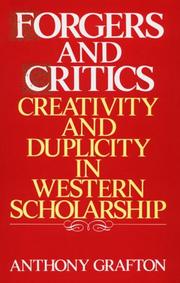
ISBN: 0691055440 9780691055442 Year: 1990 Publisher: Princeton, N.J. Princeton University Press
Abstract | Keywords | Export | Availability | Bookmark
 Loading...
Loading...Choose an application
- Reference Manager
- EndNote
- RefWorks (Direct export to RefWorks)
Literature --- Creation (Literary, artistic, etc.) --- Criticism --- Learning and scholarship --- Literary forgeries and mystifications --- Création (Arts) --- Critique --- Savoir et érudition --- Faux et supercheries littéraires --- History --- Histoire --- 347.781.03 --- 001.95 --- -Criticism --- -Learning and scholarship --- -Literary forgeries and mystifications --- -Frauds, Literary --- Literary frauds --- Literary mystifications --- Mystifications, Literary --- Authorship --- Errors and blunders, Literary --- Forgery --- Literary curiosa --- Anonyms and pseudonyms --- Imaginary books and libraries --- Pasticcio --- Erudition --- Scholarship --- Civilization --- Intellectual life --- Education --- Learned institutions and societies --- Research --- Scholars --- Appraisal of books --- Books --- Evaluation of literature --- Literary criticism --- Rhetoric --- Aesthetics --- Style, Literary --- Creative ability in art --- Creative ability in literature --- Art --- Imagination --- Inspiration --- Creative ability --- Originality --- Nabootsing. Reproductie. Fotocopie--(auteursrecht) --- Wetenschappelijk bedrog en mystificatie --- Appraisal --- Technique --- Evaluation --- -Nabootsing. Reproductie. Fotocopie--(auteursrecht) --- 001.95 Wetenschappelijk bedrog en mystificatie --- 347.781.03 Nabootsing. Reproductie. Fotocopie--(auteursrecht) --- -001.95 Wetenschappelijk bedrog en mystificatie --- Frauds, Literary --- Création (Arts) --- Savoir et érudition --- Faux et supercheries littéraires --- Literary forgeries and mystifications - History. --- Creation (Literary, artistic, etc.) - History. --- Learning and scholarship - History. --- Criticism - History. --- Literary forgeries and mystifications - History --- Creation (Literary, artistic, etc.) - History --- Learning and scholarship - History --- Criticism - History
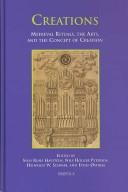
ISBN: 9782503522951 2503522955 9782503538334 Year: 2007 Volume: 2 Publisher: Turnhout Brepols
Abstract | Keywords | Export | Availability | Bookmark
 Loading...
Loading...Choose an application
- Reference Manager
- EndNote
- RefWorks (Direct export to RefWorks)
The meanings of the noun ‘creation’, and the verb ‘to create’, range from the traditional theological idea of God creating ex nihilo to a more recent sense of the process of artistic conception. This collection of thirteen essays, written by scholars of music, literature, the visual arts, and theology, explores the complicated relationship between medieval rituals and theology, and the development of an idea of human artistic creation, which came to the fore in the sixteenth century.The volume concentrates on the period from the Carolingians to the Counter-Reformation but also includes some twentieth-century musicians. Each essay is dedicated to a particular topic concerned with ritual or artistic beginnings, inventions, harmony and disharmony, as well as representations or celebrations of creation. Central themes include the interplay of the ideas of God as creator, of God acting and recreating in medieval liturgy, of God as artist—the deus artifex of the Pythagorean cosmology, which was occasionally referred to as recently as the early nineteenth century—and, finally, of the homo creator, a concept in which man reflected (and eventually replaced) God in his artistic creativity.This book therefore features new, significant, individual contributions from a range of scholarly disciplines, but, taken as a whole, it also constitutes a complex interdisciplinary study, with large-scale historical constructions.
Art --- Christian theology --- Religious studies --- anno 500-1499 --- Creation dans la litterature --- Creation in literature --- Schepping in de literatuur --- Creation (Literary, artistic, etc.) --- Liturgy and the arts --- Creation in art. --- Creation in literature. --- Création (Arts) --- Liturgie et arts --- Création dans l'art --- Création dans la littérature --- History --- Religious aspects --- Christianity. --- Histoire --- Aspect religieux --- Christianisme --- 930.85.42 --- Cultuurgeschiedenis: Middeleeuwen --- Creation in art --- Philosophy --- Philosophy & Religion --- Aesthetics --- Christianity --- 930.85.42 Cultuurgeschiedenis: Middeleeuwen --- Création (Arts) --- Création dans l'art --- Création dans la littérature --- Arts and liturgy --- Arts --- Creative ability in art --- Creative ability in literature --- Imagination --- Inspiration --- Literature --- Creative ability --- Originality --- Creation --- Creation as a topic in art --- Religious aspects&delete& --- Godsdienstwetenschap --- Christelijke theologie --- Kunst --- Creation (Literary, artistic, etc.) - History - To 1500. --- Creation (Literary, artistic, etc.) - Religious aspects - Christianity. --- Liturgy and the arts - Europe - History - To 1500.
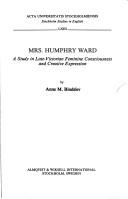
ISBN: 9122007318 9789122007319 Year: 1985 Volume: 63 Publisher: Stockholm : Almqvist & Wiksell,
Abstract | Keywords | Export | Availability | Bookmark
 Loading...
Loading...Choose an application
- Reference Manager
- EndNote
- RefWorks (Direct export to RefWorks)
Feminism and literature --- Women and literature --- Psychological fiction, English --- Feminist fiction, English --- Creation (Literary, artistic, etc) --- Femininity in literature --- History --- History and criticism --- Ward, Humphry, --- Criticism and interpretation --- Creation (Literary, artistic, etc.) --- -Feminism and literature --- -Feminist fiction, English --- -Women and literature --- -Literature --- English feminist fiction --- English fiction --- Literature --- English psychological fiction --- Femininity (Psychology) in literature --- Creative ability in art --- Creative ability in literature --- Art --- Imagination --- Inspiration --- Creative ability --- Originality --- -Bibliography --- Women authors --- Ward, Humphry Mrs. --- -Criticism and interpretation --- Femininity in literature. --- History and criticism. --- -History and criticism --- Arnold, Mary Augusta, --- Mrs. Humphry Ward, --- Ward, Mary Augusta Arnold, --- Criticism and interpretation. --- Ward, Mary Augusta, --- Ward, Humphrey, --- Ward, T. H., --- Feminism and literature - Great Britain - History - 19th century --- Women and literature - Great Britain - History - 19th century --- Psychological fiction, English - History and criticism --- Feminist fiction, English - History and criticism --- Creation (Literary, artistic, etc) - History - 19th century --- Ward, Humphry, - Mrs, - 1851-1920 - Criticism and interpretation --- Grande-bretagne --- Femmes --- 19e siecle --- Conditions sociales --- Ward, Humphry, - Mrs, - 1851-1920
| Listing 1 - 10 of 12 | << page >> |
Sort by
|

 Search
Search Feedback
Feedback About UniCat
About UniCat  Help
Help News
News